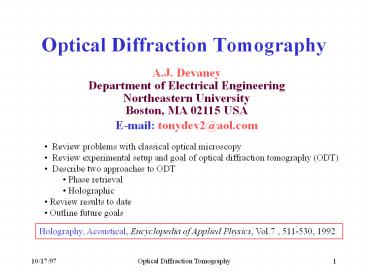Coherent Optical Tomography - PowerPoint PPT Presentation
1 / 12
Title:
Coherent Optical Tomography
Description:
Optical Diffraction Tomography A.J. Devaney Department of Electrical Engineering Northeastern University Boston, MA 02115 USA E-mail: tonydev2_at_aol.com – PowerPoint PPT presentation
Number of Views:147
Avg rating:3.0/5.0
Title: Coherent Optical Tomography
1
Optical Diffraction Tomography
A.J. Devaney Department of Electrical
Engineering Northeastern University Boston, MA
02115 USA E-mail tonydev2_at_aol.com
- Review problems with classical optical
microscopy - Review experimental setup and goal of optical
diffraction tomography (ODT) - Describe two approaches to ODT
- Phase retrieval
- Holographic
- Review results to date
- Outline future goals
Holography, Acoustical, Encyclopedia of Applied
Physics, Vol.7 , 511-530, 1992
2
Whats Wrong With Optical Microscopy?
- Illuminating light spatially coherent over small
scale - Poor image quality for 3D objects
- Need to thin slice
- Cannot image phase only objects
- Need to stain
- Need to use special phase contrast methods
- Require high quality optics
3
Experimental Setup
Digital Camera
Digital Camera Images Intensity Distribution Over
Diffraction Plane
Image is Gabor hologram of diffraction plane
field distribution
4
Inverse Problem
Diffraction Plane
d
Measure transmitted intensity over diffraction
plane
transmitted wave
Inverse Problem Given intensity of transmitted
wave estimate the complex
index of refraction distribution of
the object.
- Difficulties
- Phase Problem
- Phase retrieval
- Holography
- Quantitative Inversion
- Diffraction tomography
- Born Model
- Rytov Model
- Limited Data
- Multiple experiments
5
Scattering Models
Born Model
Rytov Model
Diffraction tomography solves inverse problem
within either Born or Rytov approximation.
Requires phase of field.
6
Why Tomography?
Measurement Plane
Integral along straightline ray path Inversion
via CT
Diffraction tomography (DT) is generalization of
CT to diffracting wavefields
- Inversion methods include
- Filtered backpropagation
- Generalized ART and SIRT
- Various non-linear and limited view algorithms
7
Diffraction Tomography
Scattered Field
Filtering
Filtered Scattered Field
Backpropagation
Induced Source
Filtered Backpropagation Algorithm
Sum over Views
8
Quality of Inversion
Point Spread Function approaches delta function
as number of views and wavenumber k approach
infinity
9
Phase Retrieval
- Phase Retrieval
- Gerchberg Saxton iterative procedure
- Approximate algebraic method
Diffraction tomography (DT) generates
quantitative image of real and imaginary parts of
objects index of refraction distribution from
complex (amplitude and phase) distribution of
field
10
Holography
Filter and backpropagate
A.J. Devaney, Phys. Rev. Letts. 62 (1989)
Q
11
Born Inversion Procedures
- Phase retrieval
Measured intensity distribution(s)
Diffraction Tomographic Reconstruction Algorithm
Complex index of refraction distribution of object
d
backpropagated filtered data
Diffraction Plane
Can employ single view theory to deal with thin
phase only objects
12
Quest for a Better Microscope
Coherent Tomographic Microscope
- Use coherent light and one or more Gabor
holograms of diffraction plane field - Employ phase retrieval and DT reconstruction
algorithm to reconstruct object - Employ direct holographic based DT
reconstruction algorithm - Can operate in thin object or thick object mode
Comparison with scanning confocal microscope
- Theoretical better image quality
- No need to stain or use floresence
- Much less expensive































